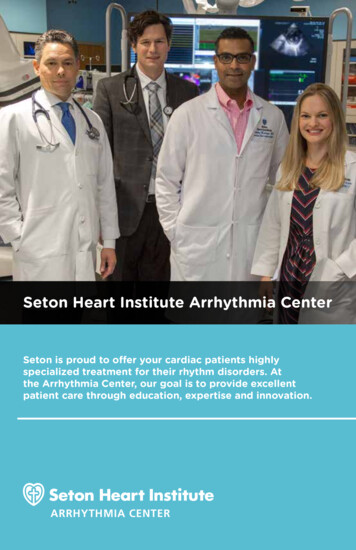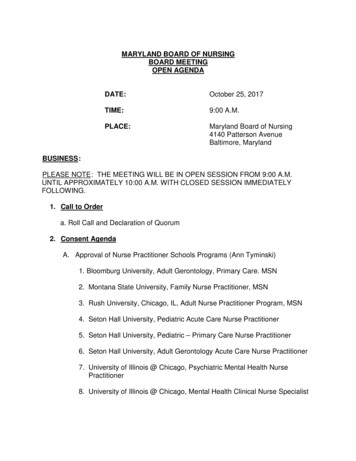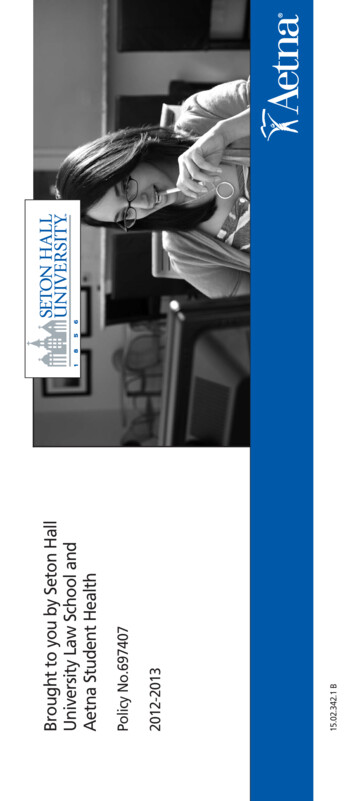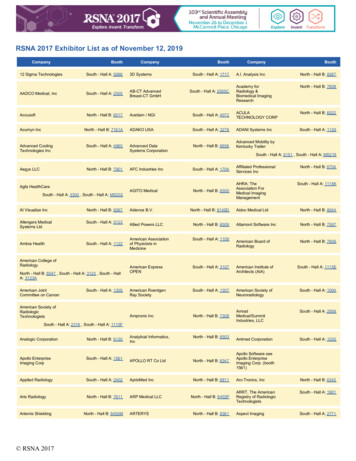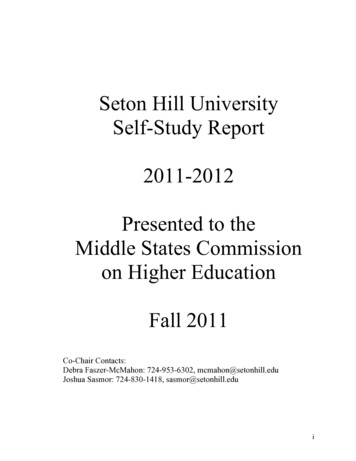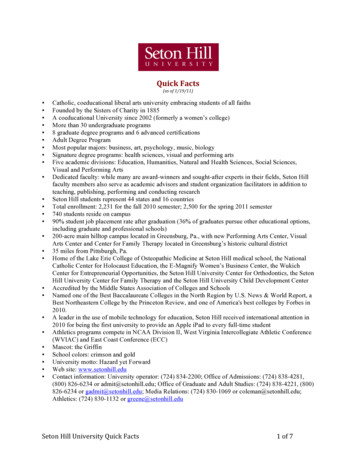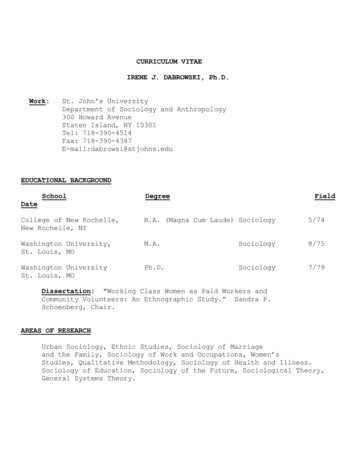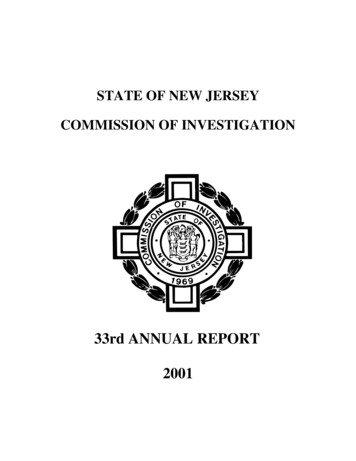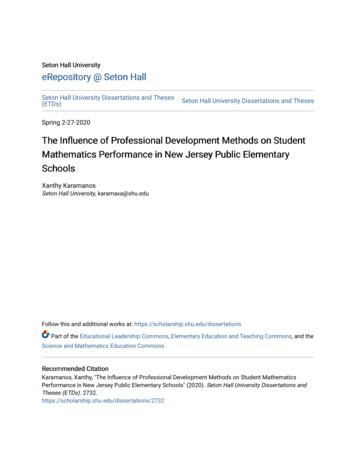
Transcription
Seton Hall UniversityeRepository @ Seton HallSeton Hall University Dissertations and Theses(ETDs)Seton Hall University Dissertations and ThesesSpring 2-27-2020The Influence of Professional Development Methods on StudentMathematics Performance in New Jersey Public ElementarySchoolsXanthy KaramanosSeton Hall University, karamaxa@shu.eduFollow this and additional works at: https://scholarship.shu.edu/dissertationsPart of the Educational Leadership Commons, Elementary Education and Teaching Commons, and theScience and Mathematics Education CommonsRecommended CitationKaramanos, Xanthy, "The Influence of Professional Development Methods on Student MathematicsPerformance in New Jersey Public Elementary Schools" (2020). Seton Hall University Dissertations andTheses (ETDs). 2
The Influence of Professional Development Methods onStudent Mathematics Performance in New Jersey Public Elementary SchoolsbyXanthy KaramanosSubmitted in partial fulfillment of the requirements for the degreeDoctor of EducationDepartment of Education Leadership, Management and PolicySeton Hall UniversityFebruary 2020
2020 Xanthy Karamanos
PROFESSIONAL DEVELOPMENT AND STUDENT PERFORMANCEAbstractThis quantitative study was developed to determine the influence of professional developmentmethods on student academic performance in elementary mathematics. The study also reviewsthe relationship between content that was delivered in professional development programs andstudent performance. Additionally, the research analyzes the difference in student mathperformance when professional development decisions are made by administrators versus amixed group of stakeholders. An online survey was conducted to collect data from district- andschool-level administrators in New Jersey public school districts that serve elementary studentsfrom grades three to six. The study includes representation from 11.4% of public school districtsacross the state. The results of the survey were examined with public data from New JerseyDepartment of Education district performance reports. Regression models were used for each ofthe three research questions and identified the control variables as the percentage of studentswith disabilities, the percentage of English learners, and the percentage of economicallydisadvantaged students. The results indicate that the content that was delivered and the decisionmaker were more significant factors for the influence of professional development on studentacademic performance compared to the provided methods.Keywords: professional development, student academic performance, mathematics,elementaryii
PROFESSIONAL DEVELOPMENT AND STUDENT PERFORMANCEDedicationThis work is dedicated to the memory of Dr. Gerard Babo, an extraordinary, patient, andcaring teacher who taught me to never doubt myself and helped me believe that the sky is thelimit. May his memory be eternal.iii
PROFESSIONAL DEVELOPMENT AND STUDENT PERFORMANCEAcknowledgementsI would like to acknowledge all of the people who have supported me throughout thedissertation process and my graduate work at Seton Hall.First, I would like to sincerely thank my mentor, Dr. Reid, for his constant support. I amgrateful for his guidance and would not have made it this far without his patience and kindness. Iwould also like to thank my committee member, Dr. Blissett for (patiently) answering themillions of statistics questions I had throughout my coursework. Thank you to Dr. Bertolini forjoining my committee and for the valuable input he has provided. Thank you all for taking thetime to work with me on my committee and always having confidence in me.I would like to express my gratitude to all of my professors at Seton Hall that have taughtme many valuable leadership lessons throughout my studies, including current and pastprofessors: Dr. Gutmore, Dr. Corino, Dr. Kuchar, and Dr. Walker. Thank you!Finally, words cannot express how grateful I am to my family and friends for theirconstant encouragement: To my parents, Christos and Stalo, thank you for your unconditionallove, support, and patience. To my Yiayias, thank you for always showering me with love andhome cooked meals. To my brothers, family, and friends, thank you for holding me accountable,reminding me to have fun, and constantly asking, “how much longer?” To my favorite principal,Steven Preville, thank you for being the greatest coach a novice leader could’ve asked for. To allof my BFE family (especially Mollie, Maria, Lindsay, Chelsea, Elisa, Steph) thank you for beingthe best cheerleaders. To Aimee and Dr. Jeff, thank you for always keeping me focused. To Rob,thank you for believing in me and refilling my water bottle whenever my nose was stuck in abook. I am eternally grateful for all of you.iv
PROFESSIONAL DEVELOPMENT AND STUDENT PERFORMANCETable of ContentsABSTRACT . iiDEDICATION . iiiACKNOWLEDGEMENTS . ivTABLE OF CONTENTS vLIST OF TABLES . ixLIST OF FIGURES . xCHAPTER I: INTRODUCTION 1Context of the Problem . 1Problem Statement . 3Purpose of the Study . 4Significance of the Study 4Theoretical Framework . 5Research Design . 7Research Questions . 8Limitations and Delimitations . 9Definition of Terms . 10Organization of the Study . 12CHAPTER II: REVIEW OF LITERATURE . 13History of Professional Development in School Districts 13Purpose of Professional Development . 16Linking to Student Academic Performance . 17Designing Professional Development . 19v
PROFESSIONAL DEVELOPMENT AND STUDENT PERFORMANCEMethods of Professional Development . 23In-Service Training. . 23Out-of-district Workshop. . 24Online Learning 24Job-embedded Professional Development 25Professional Learning Community (PLC) . 26Site-based Coaching . 26Stakeholders and Decision Making . 27Professional Development in Mathematics . 29Factors to Designing Effective Professional Development . 30Gaps in the Literature . 32CHAPTER III: METHODOLOGY . 34Introduction . 34Research Design 36Population . 36Sampling . 37Survey Questions and Main Themes 38Control Variables . 41Validity and Reliability . 42Data Collection . 43Data Analysis 44Limitations and Delimitations . 46CHAPTER IV: RESULTS 50vi
PROFESSIONAL DEVELOPMENT AND STUDENT PERFORMANCEIntroduction . 50Overview of Data . 51Research Question #1 . 54Research Question #2 . 57Research Question #3 . 62CHAPTER V: CONCLUSIONS AND RECOMMENDATIONS . 69Introduction . 69Summary of Findings 71In-Service Trainings . 72Out-of-district Workshops 73Online Learning 73Job-Embedded Professional Development . 74Professional Learning Communities . 74Site-Based Coaching . 75Content Delivered . 76Professional Development Decision Makers . 77Implications for Practice and Policy . 78Implications for Practice . 79Implications for Policy . 80Recommendations for Future Research 82Conclusion 85REFERENCES . 86APPENDIX . 93vii
PROFESSIONAL DEVELOPMENT AND STUDENT PERFORMANCEAppendix A. Data Collection Tool . 93Appendix B. Direction of the New Jersey Assessment System and Spring 2019Results 108viii
PROFESSIONAL DEVELOPMENT AND STUDENT PERFORMANCEList of TablesTable 1. Descriptive Statistics for State Mathematics Performance Trends . 48Table 2. Descriptive Statistics for Control Variables in Sample and all Statewide ElementarySchool Districts. . . . . 53Table 3. Administrative Positions of Respondents in Sample . 54Table 4. Means for Methods of Professional Development Provided . . 56Table 5. Regression Model for Methods of Professional Development Provided. . 57Table 6. Means for Content Delivered in Professional Development. . . 60Table 7. Regression Model for Content Delivered in Professional Development . . 61Table 8. Means for the Planner of Professional Development: Administrators or MixedStakeholders . 66Table 9. Regression Model for the Planner of Professional Development. . . . 67ix
PROFESSIONAL DEVELOPMENT AND STUDENT PERFORMANCEList of FiguresFigure 1. Framework for Studying the Effects of Professional Development on Teachers andStudents (Desimone, 2009) . 18Figure 2. Model of Relationship between Professional Development and Improvements inStudent Learning (Guskey & Sparks, 2002) . 20x
PROFESSIONAL DEVELOPMENT AND STUDENT PERFORMANCEChapter IIntroductionContext of the ProblemK-12 public education is an ongoing topic of conversation. From President Lyndon B.Johnson’s Elementary and Secondary Education Act (ESEA) in 1965 and President George W.Bush’s No Child Left Behind Act (NCLB) of 2001 to President Barack Obama’s Every StudentSucceeds Act (ESSA) in 2015, politicians and governing bodies have constantly changed thelandscape of education in a variety of ways. Federal, state, and local governments continue toinfluence public school funding, standards, and teaching quality. Throughout years of change,providing students with a high-quality education has remained a priority.One way in which these governments have attempted to ensure a high-quality educationfor students is by focusing on teacher quality. Research has consistently evidenced that teacherquality is the most important school-based factor for improving student outcomes in terms of, forexample, achievement, attendance, and graduation (Darling-Hammond, 2000; Garet, Porter,Desimone, Birman, & Yoon, 2000; Guskey, 2009; Mizell, 2010). In 2004, NCLB stated that, by2006, all teachers must be considered “highly qualified” to obtain teaching positions in publicschools. The state of New Jersey defines a highly qualified teacher as an individual with at leasta bachelor’s degree, a valid state certification, and demonstrated expertise in their core academicsubject area (NJDOE, 2014).Although hiring individuals who are deemed “highly qualified” to teach students is a vitalstep, it is critical for teachers to continue their professional growth throughout their careers, asresearch has indicated that “professional development is viewed as an integral part of one’scareer cycle” (Guskey, 1994; Zambak, Alston, Marshall, & Tyminski, 2017). Over the decades,1
PROFESSIONAL DEVELOPMENT AND STUDENT PERFORMANCEstates, school districts, and researchers have dedicated a significant amount of time and resourcesto studying the effects of professional development. They have found that high-quality,sustained, and intensive professional development has an active role in student learning andachievement (Darling-Hammond, Wei, Andree, Richardson, & Orphanos, 2009). Professionaldevelopment provides an opportunity for districts to support teachers in learning and advancingin their content areas and professions; therefore, it is important for professional development tobe executed thoroughly and thoughtfully (Corcoran, 1995; Guskey, 2009; Kelly, 2012).In an effort to improve the quality of teaching, districts have spend billions of federaldollars annually on professional development that aims to enhance student performance and meetfederal and state mandates (Calvert, 2016; Guskey, 2009; Jaquith, Mindich, Wei, & DarlingHammond, 2010; Yoon, Duncan, Lee, Scarloss, & Shapley, 2007). For example, New Jerseyrequires all teaching staff to complete 20 hours of professional development each year, whichforces public schools to not only allow designated time for staff to engage in learning but alsoallocate resources and money to fulfill these demands.As the digital, fast-paced world continues to grow, the available types of professionaldevelopment are constantly evolving. For example, states and school districts now offer live orpre-recorded webinars, conferences that are presented by organizations, social media outlets, andout-of-district workshops. Other professional development methods that need more arrangingand planning but are still readily available to teachers include professional learning communities(PLCs), in-service trainings, and job-embedded professional development. Today, teachers havean unprecedented level of access to professional development at their preferred time andlocation. As staff development opportunities become more easily accessible, it is important tocritically evaluate these opportunities and determine how, if at all, they improve teacher quality.2
PROFESSIONAL DEVELOPMENT AND STUDENT PERFORMANCEProblem StatementFor years, public school districts have been spending billions of dollars on variousprofessional development activities (Borko, 2004; Corcoran, 1995; Guskey 2009; Guskey &Yoon, 2009; Jaquith et al., 2007; Kedzior, 2004; Kelly 2012; Little, 1993; Valli, Cooper, &Frankes, 2016). With laws such as NCLB and ESSA, districts have funneled money intoprograms to help remediate student learning with the hope of increasing student academicperformance to meet federal and state demands. The provision of professional development ismore likely to improve a program than setting up “band-aid” solutions, such as remedialprograms, support teachers, interventionists, and content specialists (Kelly, 2012). When districtsallocate money for professional development, they need to ensure that they are receiving servicesthat will have the strongest impact on student learning.Scholars such as Guskey (2003, 2009), Rebora (2004), Rotermund, DeRoche, and Otterm(2017), and Villegas-Reimers (2003) have found that professional development is a necessarycomponent to improve student learning. Research has identified effective professionaldevelopment methods through pre-post studies, classroom observations, and teacher surveys toconnect changes in teacher practices to student academic performance. Current research has alsooutlined the most frequently used types of professional development in districts; however, fewstudies have linked these types to student academic performance.Before districts expend more time, resources, and funds for different professionaldevelopment methods, it is vital to understand the impact of these methods on academicperformance. Further research is necessary to identify the professional development methods3
PROFESSIONAL DEVELOPMENT AND STUDENT PERFORMANCEwith the greatest potential influence on student academic performance as well as any observablepatterns between professional development methods and student academic performance.Purpose of the StudyThe purpose of this study is to determine if there is a relationship between studentacademic performance and the type of professional development that is provided to staff whoteach elementary mathematics. The study focuses on the most commonly reviewed types ofprofessional development in the literature and research, which include in-service trainings, outof-district workshops, online learning, job-embedded professional development, PLCS, and sitebased coaching. Based on the findings, district administrators can obtain more information abouttarget areas for professional development efforts, such as content and planning, to supportteaching and learning within their elementary school classrooms.Significance of the StudyThis research presents strengths that include the opportunity to gather information onhow districts have implemented professional development across the state of New Jersey. As across-sectional study, it provides an understanding of professional development methods that arecurrently applied in public elementary schools. Furthermore, the data that were collected builtupon the findings of previous research and can support administrators in decision-makingconcerning the implementation of professional development.This study could benefit students in multiple ways. First, it can provide schooladministrators and policymakers with a deeper understanding of the influence of variousprofessional development methods on student academic performance. The research also raises4
PROFESSIONAL DEVELOPMENT AND STUDENT PERFORMANCEawareness of the importance of strategically planning the content that is delivered in professionaldevelopment programs to promote student learning. Additionally, it reviews the difference in therelationship between professional development and student performance based on who makesthe decisions about district professional development plans and programs. Overall, the studyoffers information that can guide school personnel to make decisions about professional learningthat will have the greatest impact on students.Theoretical FrameworkThe National Staff Development Council (NSDC, 2001) has developed 12 standards forstaff development to support improvements in student learning. These standards are split intothree categories that mirror the model of Guskey and Sparks (2002) for the relationship betweenprofessional development and improvements in student learning. The theoretical framework ofthis model illustrates that many elements are involved in improving student academicperformance.Guskey and Sparks (2002) and the NSDC (2001) have identified three parts of qualityprofessional development: content, process, and context. These three aspects together helpadministrators plan for high-quality professional development with the goal of impacting theknowledge and practice of teachers, which could in turn improve student learning and academicperformance (Guskey & Sparks, 2002). This theory also connects to the model by the Institute ofEducation Science on “How Professional Development Affects Student Achievement,” whichlinks professional development to teacher knowledge, skills, and pedagogy and, subsequently, toits effects on student learning (Desimone, 2009; Yoon et al., 2007). Although professionaldevelopment may not have a direct effect on student academic performance, “the relationship5
PROFESSIONAL DEVELOPMENT AND STUDENT PERFORMANCEbetween professional development and improvements in student learning is complex andmultifaceted, it is not random or chaotic” (Guskey & Sparks, 2002, p. 5), and it should beplanned thoroughly, purposefully, and with extensive thought (Desimone, 2009; NSDC, 2001;Yoon et al., 2007).Content: The content characteristic describes the goals and objectives of professionaldevelopment. Strategically planning the content in professional development “improves thelearning of all students deepens educators’ content knowledge, provides them with researchbased instructional strategies to assist students in meeting rigorous academic standards” (NSDC,2001). Professional development content can vary from content-area-specific programs andresources to student learning standards and practices, pedagogy, instructional strategies, andlesson design.Process: While content is important, the process of professional development is avaluable facet of the model that directly connects to this study. The process characteristicsdescribe the method and activities within the professional development program (Guskey &Sparks, 2002). According to the NSDC (2001), when considering the process of professionaldevelopment, standards to evaluate consist of data-driven, evaluative (multiple sources ofinformation), research-based, design, learning (understanding of human development), andcollaborative aspects (p. 2).Context: The context encompasses the educators who are involved as well as theirstudents, the environment, the organization, and the culture of the professional development(Guskey & Sparks, 2002). The NSDC (2001) has also connected the context to resources forsupporting professional learning. Some context resources are technology, substitutes to cover6
PROFESSIONAL DEVELOPMENT AND STUDENT PERFORMANCEclasses, and materials. With regard to students, aspects of the context may include studentsubgroups and demographics that are identified within a class, school, or district.Content, process, and context all work together as characteristics of quality performancedevelopment. When these three characteristics are evaluated, administrators can plan for highquality and meaningful professional development that impacts the knowledge and practice ofteachers. Guskey and Sparks’s (2002) model for the relationship between professionaldevelopment and improvements in student learning dictates that such impacts to the knowledgeof teachers have a direct effect on student learning outcomes. In this research, these threecharacteristics were incorporated into the survey to collect data that could address the researchquestions of this study.Research DesignThis research was conducted in the form of a quantitative study by creating a survey toadminister to public school district administrators. The survey collected information about themethods of professional development that the districts offer, the content that they delivered, andthe decision maker. The survey was utilized to gather information from districts and did nottarget perceptions or pose questions about evaluating the effectiveness. The basic constructs ofinterest in this study were the content, process, and context of professional development, whichdefine the professional development methods, the delivered content, and the planning process ofprofessional development.These main themes were used to develop a survey that helped to answer the researchquestions of this study. The items from this survey were modified from those of a previoussurvey that was employed by the researcher Dr. Christine Scheffert Lowden to evaluate the7
PROFESSIONAL DEVELOPMENT AND STUDENT PERFORMANCEeffectiveness of professional development (Scheffert Lowden, 2003) as well as a survey by theNational Center for Education Statistics (NCES) called the Schools and Staffing Survey Teacher Questionnaire (2011–2012). Both of these surveys have been used to gather informationon professional development implementation in various capacities. Although the surveys weredesigned for different research purposes, a modification of their items supported the collection ofrelevant data for addressing the research questions of the present study.After the respondents submitted the survey, student academic performance data,including subgroup achievement data, were collected from New Jersey Department of Education(NJDOE) public district performance reports. Demographic and student subgroup informationwas gathered from the National Center for Education Statistics Common Core of Data. Thesedata were utilized to run multiple regression models to determine the existence of a relationshipbetween the method of professional development and students who met or exceeded expectationsin the district performance reports. Regression models were also run to identify the influence ofthe content of the professional development and the decision maker behind the professionaldevelopment on student academic performance.Research QuestionsPrevious research has studied teachers’ perceptions of professional development,classroom observations of changing pedagogy, and pre/post-test research on specific professionaldevelopment methods. However, there is limited research on the link between professionaldevelopment methods and student academic performance. The present quantitative researchexplores the following questions:8
PROFESSIONAL DEVELOPMENT AND STUDENT PERFORMANCEo How does the method of professional development influence student academicperformance?o How does the content of professional development influence student academicperformance?o How does the professional development decision maker influence the relationshipbetween the method of professional development and student academicperformance?Limitations and DelimitationsDespite the strengths of this survey, some delimitations should be highlighted. While across-sectional study may provide an understanding of the type of professional development thatoccurs in schools, it is not able to establish a causal relationship, as it does not make anyobservations over time. Furthermore, convenience sampling was performed to collect responsesin the easiest way for the researcher, which limits the ability to generalize the results. Based onthe convenience sample and the respondents, the variety of districts with diverse demographicswas somewhat limited, which influenced the results of this study.Other limitations may have influenced the relationship between districts’ academicperformance and professional development that cannot be captured by the data. Since this studyfocuses on math performance, one factor was the district’s professional development plan andgoals for the school year. While the survey defined the type of professional development, thequality of certain professional development methods, such as job-embedded learning, PLCs, andcoaching, can present differently across districts and schools. There may also be unforeseen9
PROFESSIONAL DEVELOPMENT AND STUDENT PERFORMANCEfactors that could impact the relationship, such as financial changes and budget cuts, districtrestructuring, and drastic changes in enrollment or staffing.Definition of TermsThe following terms are defined to clarify key words that are used throughout the study: Professional development, which is also referred to as staff development or professionallearning, consists of educational learning that impacts an individual’s professional careerand growth. The NJDOE has defined professional development as “professional learningopportunities aligned with student learning and educator development needs and school,school district, and/or state improvement goals” (NJDOE, 2013). Effective professional development has been described by Mizell (2010) as a way to“enable educators to develop the knowledge and skills they need to address students’learning challenges” and requires thoughtful planning, implementation, and feedback.“Professional development is not effective unless it causes teachers to improve theirinstruction” (p. 10). A professional development method, which may also be known as a model or type,identifies the kind of professional development that is offered. Such methods includecoaching, observations, webinars, workshops, and conferences, and they may bereferenced as professional development types, delivery, or modes. Professional development content refers to the information that is presented during aprofessional development session or, alternatively, content delivered in professionaldevelopment. This study discusses professional development content in the area ofelementary mathematics.10
PROFESSIONAL DEVELOPMENT AND STUDENT PERFORMANCE Student academic performance is defined by an evaluation of a student’s level ofunderstanding of learning standards and objectives. Synonyms include student learningoutcomes and student proficiency. For this research, student academic performance wasmeasured through an analysis of district performance reports that are available in a publicdatabase of the NJDOE. These reports review data that are connected to studentperformance on statewide assessments. In-service training is a professional development method that is hosted by the district as astand-alone, one-time activity. In-service trainings are presented in a large group settingby an outsourced presenter or in-district staff. An out-of-district workshop refers to a professional development workshop that staff mayattend as a stand-alone, one-time activity. An out-of-district workshop is presented in alarge group setting by an out-of-district presenter and focuses on a specific topic. Online learning refers to online courses or virtual learning experiences that teachers mayundergo as part of their professional development. Job-embedded professional development is, according to the National ComprehensiveCenter for Teacher Quality, “a shared, ongoing process that is locally rooted and makes adirect connection between learning and application in daily practice and is designed toenhance teachers’ content specific instruction practices” (Croft, Coggshall, Dolan,Powers, & Killion, 2010). This method is presented in a small group setting and may beled by a district staff developer or out-of-district consultant. A professional learning community (PLC) has been defined by Learning Forward, aprofessional learning association, as a community of educators in a department, team,school, or district who “convene regularly and frequently during the workday to
time to work with me on my committee and always having confidence in me. I would like to express my gratitude to all of my professors at Seton Hall that have taught me many valuable leadership lessons throughout my studies, including current and past professors: Dr. Gutmore, Dr. Corino, Dr. Kuchar, and Dr. Walker. Thank you!
